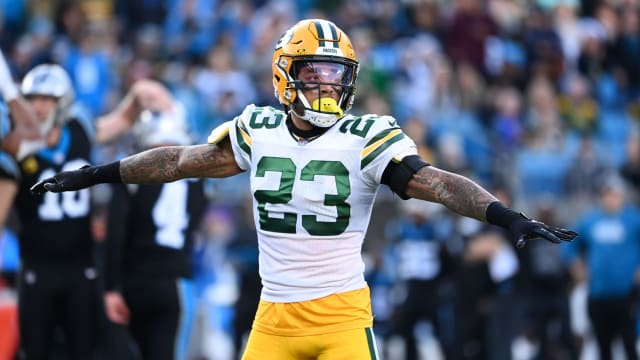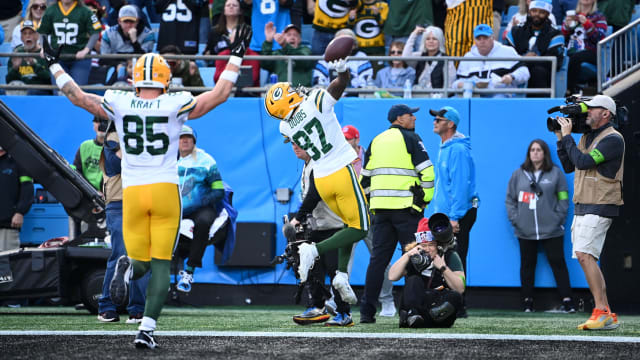
Tucker Kraft Ending Packers’ Third-Round NFL Draft Curse
GREEN BAY, Wis. – What does Tucker Kraft have in common with Sean Rhyan, Amari Rodgers, Josiah Deguara, Jace Sternberger, Oren Burks, Montravius Adams, Kyler Fackrell, Ty Montgomery, Khyri Thornton and Alex Green?
Other being third-round draft picks by the Green Bay Packers, nothing.
From the selection of Green, a running back from Hawaii in 2011, to Rhyan, an offensive lineman from UCLA in 2022, the Packers’ third-round picks have ranged from inconsistent to inept. Whether it was general manager Brian Gutekunst or the late Ted Thompson making the pick, the Packers hardly could have done worse by picking names from a hat.
Approximate Value is a Pro Football Reference tool used to compare players across positions and across eras. By AV, Green Bay’s top third-round draft picks were Montgomery (14), Richard Rodgers (12) and Fackrell (10). Combined, the 10 players had an AV of 58. League-wide, 20 third-round picks had an AV of more than 58.
Looking at it another way, Green Bay’s third-round picks from 2011 through 2022, of course, failed to make a single Pro Bowl. Richard Rodgers leads the group with 29 career starts.
League-wide, 44 third-rounders have been selected to at least one Pro Bowl. By starts, 173 players have more than Rodgers, including 109 with 50-plus starts and 29 with 100-plus starts.
Gutekunst’s first five third-round choices were Burks in 2018, Sternberger in 2019, Deguara in 2020, Rodgers in 2021 and Rhyan in 2022. Burks has 14 career starts, including three for the 49ers this season. He’s followed by Deguara (10), Sternberger (2), Rodgers (1) and Rhyan (0). That’s 27 starts; 66 individuals have more.
Enter Kraft, who has exorcised the third-round curse.
The climb from South Dakota State to the NFL is steep. In his first four games, Kraft played 13, two, 10 and 13 snaps. The next six games, his playing time ranged from 19 to 35 snaps. And then fellow rookie tight end Luke Musgrave, the team’s second-round standout, suffered a kidney injury against the Chargers.
That thrust Kraft into an enormous role. With Musgrave out of action the last five games, Kraft’s share of the playing time has ranged from 92 percent of the snaps to 100 percent.
The production has been there, too: two catches for 15 yards and one touchdown vs. Detroit, three receptions for 37 yards against Kansas City, four receptions for 64 yards against the Giants, four receptions for 57 yards and one touchdown against Tampa Bay and four receptions for 60 yards against Carolina.
“It goes to the mindset of you never know, right?” tight ends coach John Dunn said. “You work, you work, you work, and then here it is, your chance, your opportunity, and it’s up to you to take advantage of it. And he certainly has.
“It’s been great for him building confidence. There’s nothing like doing it, right? We talk about it in the meeting room. You practice, all those things are critically important, but going out there and doing it in the game, when it counts, keeping score and what it does for your confidence. I’m happy for him and the way he’s going about his business.”
During his first five games as the team’s full-time tight end, Kraft caught 17 passes for 233 yards and two touchdowns while providing credible blocking. During that span, only Detroit’s Sam LaPorta has more catches (24), yards (284) and touchdowns (five) among rookie tight ends. Among all tight ends during those five games, Kraft is 15th in catches, 12th in yards, 10th in first down, tied for seventh in touchdowns.
“He’s very talented,” Dunn said. “I can’t say how hard he works. Just in terms of how he goes about his business – and it hadn’t changed, right? When he wasn’t playing as much to now, he just works and works and works and works. What you do in the dark eventually will come out in the light, right? That’s kind of how he’s attacked it.”
Kraft’s calling card in college was yards after the catch. While it came against overmatched FCS-level defenders, he averaged 7.7 YAC, according to PFF. How would that translate against NFL defenders? Over the last five games, 32 tight ends have been targeted at least 10 times. Kraft’s 8.7 YAC per catch trails only 49ers star George Kittle.
On the game-winning drive against Carolina, Kraft caught a short pass between two defenders, avoided the tackle and gained 14 yards after the catch to set up a chip-shot field goal.
“I don’t step out on the field and do anything for me,” he said after the game. “Just try to be there and be a guy for my teammates, be a guy for the coaches, and I think it’s that simple. You go out there, you run every route like you’re expecting to catch the ball. You block every block like you’re the point of attack and good things will happen to the team. You just owe it to yourself, owe it to your teammates to just give your best effort every single snap.”







